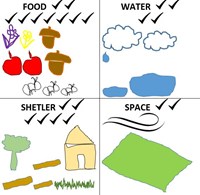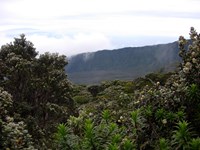- Lesson Plan (213)
- Field Trips (53)
- Distance Learning (36)
- Student Activities (24)
- Other Education Materials (6)
- Guest Speakers (5)
- Teacher Reference Materials (5)
- Traveling Trunk (5)
- Science Labs (3)
- Field Schools & Institutes (1)
- Online Galleries (1)
- Haleakalā National Park (26)
- Everglades National Park (25)
- Glacier National Park (23)
- Acadia National Park (21)
- Shenandoah National Park (12)
- National Park of American Samoa (11)
- Cowpens National Battlefield (7)
- Olympic National Park (7)
- Wrangell - St Elias National Park & Preserve (7)
- Show More ...
- Science (211)
- Social Studies (166)
- Literacy and Language Arts (73)
- Math (24)
Showing 344 results for native habitats ...
Habitat
- Type: Distance Learning
- Grade Levels: Lower Elementary: Pre-Kindergarten through Second Grade
Habitats
- Type: Lesson Plan
- Grade Levels: Lower Elementary: Pre-Kindergarten through Second Grade
•Describe the 5 major biomes on Earth •Describe the factors that make up a successful habitat
Habitat Adventure
- Type: Distance Learning
- Grade Levels: Lower Elementary: Pre-Kindergarten through Second Grade

A ranger will take your class on a virtual "hike" to discover the four different habitats of Glacier National Park. We will learn what living things need to survive and meet at least one animal that lives in each habitat. Come prepared for an adventure, as you never know what will happen in the wild!
Habitat Investigators
- Type: Distance Learning
- Grade Levels: Lower Elementary: Pre-Kindergarten through Second Grade
Habitat Is Home
Habitat Hunt
A Habitat Is A Home
Basics of Habitat
What's That Habitat
Creepy Crawly Habitat
Habitat Scavenger Hunt
- Type: Student Activities ... Other Education Materials
- Grade Levels: Lower Elementary: Pre-Kindergarten through Second Grade

Walk around a safe outside space with adult supervision and make a mark every time you see an example of food, water, shelter, and space. These are what animals need in their habitats to survive. You can write in a little dot, a checkmark, or you can even draw a little picture. Hint: A shelter could be a nest or a house, but remember it could also be the area underneath a log! Try with a partner and compare what you find!
Prairie Animals and Habitats
- Type: Distance Learning
- Grade Levels: Lower Elementary: Pre-Kindergarten through Second Grade

Badlands National Park protects 244,000 acres of mixed-grass prairie habitat and the wild animals that live in it. Prairie vegetation is mostly grasses--find out why. Then take a look at some of the wildlife (including bison, pronghorn, prairie dogs, and black-footed ferrets) that have adaptations that allow them to thrive in the prairie environment. Students participating in the in-class program may see and touch animal pelts, complete a puzzle, or complete a craft.
Habitats: 1st - 3rd Grades
Habitats: Home Sweet Home
- Type: Field Trips
- Grade Levels: Lower Elementary: Pre-Kindergarten through Second Grade

Where do animals live and why? How are their needs similar to what people need? Are humans and animals so different after all? What habitats does the park offer and who lives in them? A 0.2 mile hike of the paved Piedmont Forest Trail will follow a short talk where we will look for some park "residents". This program lasts 30 minutes to one hour.
Finding Hot Springs' Habitats
- Type: Field Trips
- Grade Levels: Upper Elementary: Third Grade through Fifth Grade

“Finding Hot Springs’ Habitats” is an environmental science program training students to “read” the many habitats of Hot Springs National Park. Students will learn about how the hot springs environment relies on a healthy ecosystem. Students analyze open air springs for water quality and thermal habitats before exploring terrestrial environments on a 0.5 mile naturalist hike. Designed for 2nd & 3rd grade Life Science lessons.
Habitat Unit Field Trip
- Type: Field Trips
- Grade Levels: Lower Elementary: Pre-Kindergarten through Second Grade
Pathways to Discovery - Model Habitat
Habitat Requirements of Pacific Salmon
- Type: Student Activities
- Grade Levels: Middle School: Sixth Grade through Eighth Grade

In this activity, students will learn about the specific habitat requirements for each Pacific salmon species, as well as, other anadromous fish of the Elwha River watershed. The ecological habitat of each salmon species includes their adult range in the ocean and the specific parts of the river, and its tributaries, that are critical spawning habitat.
Native Harvest
- Type: Lesson Plan
- Grade Levels: Middle School: Sixth Grade through Eighth Grade













